Influence of Citrus Rootstocks on Scion Growth, Hormone Levels, and Metabolites Profile of ‘Shatangju’ Mandarin (Citrus reticulata Blanco)
Abstract
1. Introduction
2. Materials and Methods
2.1. Plant Materials and Culture Conditions
2.2. Measurement of Plant Growth Parameters
2.3. Determination of Soluble Sugars Contents
2.4. Determination of Soluble Protein Contents
2.5. Determination of Enzymatic Antioxidant Activities
2.6. Determination of Endogenous Hormones Analysis
2.7. Method of Determining Metabolites
2.8. Statistical Analysis
3. Results
3.1. Effect of Rootstocks on Scion Growth
3.2. Effect of Rootstocks on Soluble Sugar and Soluble Protein Contents
3.3. Effect of Rootstocks on Enzymatic Antioxidant Activities
3.4. Endogenous Hormone Levels
3.5. Correlation Analysis of Plant Morphological Traits and Endogenous Hormones
3.6. Expression, Correlation, and PCA Analysis of Differential Metabolites
3.7. Metabolite Profiles of Dwarfing and Vigorous Rootstocks
4. Discussion
5. Conclusions
Supplementary Materials
Author Contributions
Funding
Institutional Review Board Statement
Informed Consent Statement
Data Availability Statement
Acknowledgments
Conflicts of Interest
References
- Khan, M.N.; Hayat, F.; Asim, M.; Iqbal, S.; Ashraf, T.; Asghar, S. Influence of Citrus Rootstocks on Growth Performance and Leaf Mineral Nutrition of “Salustiana” Sweet Orange [Citrus sinensis (L.). Obsek]. J. Pure Appl. Agric. 2020, 5, 2617–8680. [Google Scholar]
- Shireen, F.; Jaskani, M.J.; Nawaz, M.A.; Hayat, F. Exogenous Application of Naphthalene Acetic Acid Improves Fruit Size and Quality of Kinnow Mandarin (Citrus reticulata) through Regulating Fruit Load. J. Anim. Plant Sci. 2018, 28, 1080–1084. [Google Scholar]
- Zhou, C. The Status of Citrus Huanglongbing in China. Trop. Plant Pathol. 2020, 45, 279–284. [Google Scholar] [CrossRef]
- Khan, M.N.; Nawaz, M.A.; Ahmad, W.; Afzal, M.; Malik, A.U.; Saleem, B.A. Evaluation of Some Exotic Cultivars of Sweet Orange in Punjab, Pakistan. Int. J. Agric. Biol. 2010, 12, 729–733. [Google Scholar]
- Nawaz, M.A.; Afzal, M.; Ahmed, W.; Ashraf, M.; da Silva, J.A.T.; Akhtar, N.; Shahzad, S.M.; Ullah, H.; Hussain, Z. Exogenous Application of 2, 4-D, GA3 and NAA at Flowering Improves Yield and Quality of Kinnow Mandarin (Citrus Reticulata Blanco). Asian Australas. J. Plant Sci. Biotechnol. 2011, 5, 17–21. [Google Scholar]
- Hayat, F.; Nawaz Khan, M.; Zafar, S.A.; Balal, R.M.; Nawaz, M.A.; Malik, A.U.; Saleem, B.A. Surface Coating and Modified Atmosphere Packaging Enhances Storage Life and Quality of ‘Kaghzi Lime’. J. Agric. Sci. Technol. 2017, 19, 1151–1160. [Google Scholar]
- Hayat, F.; Iqbal, S.; Coulibaly, D.; Razzaq, M.K.; Nawaz, M.A.; Jiang, W.; Shi, T.; Gao, Z. An Insight into Dwarfing Mechanism: Contribution of Scion-Rootstock Interactions toward Fruit Crop Improvement. Fruit Res. 2021, 1, 1–11. [Google Scholar] [CrossRef]
- Hayat, F.; Qiu, C.; Xu, X.; Wang, Y.; Wu, T.; Zhang, X.; Azher, M. Rootstocks Influence Morphological and Biochemical Changes in Young ‘Red Fuji’ Apple Plants. Int. J. Agric. Biol. 2019, 21, 1097–1105. [Google Scholar] [CrossRef]
- Tworkoski, T.; Fazio, G. Hormone and Growth Interactions of Scions and Size-Controlling Rootstocks of Young Apple Trees. Plant Growth Regul. 2016, 78, 105–119. [Google Scholar] [CrossRef]
- Smolka, A.; Li, X.Y.; Heikelt, C.; Welander, M.; Zhu, L.H. Effects of Transgenic Rootstocks on Growth and Development of Non-Transgenic Scion Cultivars in Apple. Transgenic Res. 2010, 19, 933–948. [Google Scholar] [CrossRef]
- Hayat, F.; Asghar, S.; Yanmin, Z.; Xue, T.; Nawaz, M.A.; Xu, X.; Wang, Y.; Wu, T.; Zhang, X.; Qiu, C. Rootstock Induced Vigour Is Associated with Physiological, Biochemical and Molecular Changes in ‘Red Fuji’ Apple. Int. J. Agric. Biol. 2020, 24, 1823–1834. [Google Scholar]
- An, H.; Luo, F.; Wu, T.; Wang, Y.; Xu, X.; Zhang, X.; Han, Z. Dwarfing Effect of Apple Rootstocks Is Intimately Associated with Low Number of Fine Roots. HortScience 2017, 52, 503–512. [Google Scholar] [CrossRef]
- Adams, S.; Lordan, J.; Fazio, G.; Bugbee, B.; Francescatto, P.; Robinson, T.L.; Black, B. Effect of Scion and Graft Type on Transpiration, Hydraulic Resistance and Xylem Hormone Profile of Apples Grafted on Geneva®41 and M.9-NICTM29 Rootstocks. Sci. Hortic. 2018, 227, 213–222. [Google Scholar] [CrossRef]
- Van Hooijdonk, B.; Woolley, D.; Warrington, I.; Tustin, S. Rootstocks Modify Scion Architecture, Endogenous Hormones, and Root Growth of Newly Grafted ‘Royal Gala’ Apple Trees. J. Am. Hortic. Sci. 2011, 136, 93–102. [Google Scholar] [CrossRef]
- Karlidağ, H.; Aslantaş, R.; Eşitken, A. Effects of Interstock (M9) Length Grafted onto MM106 Rootstock on Sylleptic Shoot Formation, Growth and Yield in Some Apple Cultivars. J. Agric. Sci. 2014, 20, 331–336. [Google Scholar]
- Castle, W.S.; Phillips, R.L. Potentially Dwarfing Rootstocks for Florida Citrus. Proc. Proc. Intl. Soc. Citric. 1977, 2, 558–561. [Google Scholar]
- Bitters, W.P.; Cole, D.A.; McCarty, C.D. Facts about Dwarf Citrus Trees. Citrograph 1979, 64, 54–56. [Google Scholar]
- Mademba-Sy, F.; Lemerre-Desprez, Z.; Lebegin, S. Use of Flying Dragon Trifoliate Orange as Dwarfing Rootstock for Citrus under Tropical Climatic Conditions. HortScience 2012, 47, 11–17. [Google Scholar] [CrossRef]
- Zhao, D.; Yuan, J.; Xu, K.; Cheng, C.; Li, H. Selection of Morphological, Physiological and Biochemical Indices: Evaluating Dwarfing Apple Interstocks in Cold Climate Zones. N. Z. J. Crop Hortic. Sci. 2016, 44, 291–311. [Google Scholar] [CrossRef]
- Amiri, M.E.; Fallahi, E.; Safi-Songhorabad, M. Influence of rootstock on mineral uptake and scion growth of ‘Golden Delicious’and ‘Royal Gala’ apples. J. Plant Nutr. 2014, 37, 16–29. [Google Scholar] [CrossRef]
- Foster, T.M.; McAtee, P.A.; Waite, C.N.; Boldingh, H.L.; McGhie, T.K. Apple Dwarfing Rootstocks Exhibit an Imbalance in Carbohydrate Allocation and Reduced Cell Growth and Metabolism. Hortic. Res. 2017, 4, 17009. [Google Scholar] [CrossRef] [PubMed]
- Yıldırım, F.; Yıldırım, A.N.; San, B.; Ercişli, S. The Relationship between Growth Vigour of Rootstock and Phenolic Contents in Apple (Malus × Domestica). Erwerbs-Obstbau. 2016, 58, 25–29. [Google Scholar] [CrossRef]
- Chen, B.; Wang, C.; Tian, Y.; Chu, Q.; Hu, C. Anatomical Characteristics of Young Stems and Mature Leaves of Dwarf Pear. Sci. Hortic. 2015, 186, 172–179. [Google Scholar] [CrossRef]
- Shen, Y.; Zhuang, W.; Tu, X.; Gao, Z.; Xiong, A.; Yu, X.; Li, X.; Li, F.; Qu, S. Transcriptomic Analysis of Interstock-Induced Dwarfism in Sweet Persimmon (Diospyros Kaki Thunb.). Hortic. Res. 2019, 6, 1–17. [Google Scholar] [CrossRef] [PubMed]
- Hooijdonk, V.; Woolley, D.J.; Warrington, I.J.; Tustin, D.S. Initial Alteration of Scion Architecture by Dwarfing Apple Rootstocks May Involve Shoot-Root-Shoot Signalling by Auxin, Gibberellin, and Cytokinin. J. Hortic. Sci. Biotechnol. 2010, 85, 59–65. [Google Scholar] [CrossRef]
- Pérez-Alfocea, F.; Albacete, A.; Ghanem, M.E.; Dodd, I.C. Hormonal Regulation of Sourcesink Relations to Maintain Crop Productivity under Salinity: A Case Study of Root-to-Shoot Signalling in Tomato. Funct. Plant Biol. 2010, 37, 592–603. [Google Scholar] [CrossRef]
- Song, C.; Zhang, D.; Zhang, J.; Zheng, L.; Zhao, C.; Ma, J.; An, N.; Han, M. Expression Analysis of Key Auxin Synthesis, Transport, and Metabolism Genes in Different Young Dwarfing Apple Trees. Acta Physiol. Plant. 2016, 38, 43. [Google Scholar] [CrossRef]
- Kviklys, D.; Samuolienė, G. Relationships among the Rootstock, Crop Load, and Sugar Hormone Signaling of Apple Tree, and Their Effects on Biennial Bearing. Front. Plant Sci. 2020, 11, 1213. [Google Scholar] [CrossRef]
- Ma, Y.; Xue, H.; Zhang, L.; Zhang, F.; Ou, C.; Wang, F.; Zhang, Z. Involvement of Auxin and Brassinosteroid in Dwarfism of Autotetraploid Apple (Malus × Domestica). Sci. Rep. 2016, 6, 1–14. [Google Scholar] [CrossRef]
- Zheng, X.; Zhao, Y.; Shan, D.; Shi, K.; Wang, L.; Li, Q.; Wang, N.; Zhou, J.; Yao, J.; Xue, Y. Md WRKY 9 Overexpression Confers Intensive Dwarfing in the M26 Rootstock of Apple by Directly Inhibiting Brassinosteroid Synthetase Md DWF 4 Expression. N. Phytol. 2018, 217, 1086–1098. [Google Scholar] [CrossRef]
- Gregory, P.J.; Atkinson, C.J.; Bengough, A.G.; Else, M.A.; Fernández-Fernández, F.; Harrison, R.J.; Schmidt, S. Contributions of Roots and Rootstocks to Sustainable, Intensified Crop Production. J. Exp. Bot. 2013, 64, 1209–1222. [Google Scholar] [CrossRef] [PubMed]
- Talat, H.; Shafqat, W.; Qureshi, M.A.; Sharif, N.; Raza, M.K.; ud Din, S.; Ikram, S.; Jaskani, M.J. Effect of Gibberellic Acid on Fruit Quality of Kinnow Mandarin. J. Glob. Innov. Agri. Soc. Sci. 2020, 8, 59–63. [Google Scholar] [CrossRef]
- Sorce, C.; Massai, R.; Picciarelli, P.; Lorenzi, R. Hormonal Relationships in Xylem Sap of Grafted and Ungrafted Prunus Rootstocks. Sci. Hortic. 2002, 93, 333–342. [Google Scholar] [CrossRef]
- González-Mas, M.C.; Llosa, M.J.; Quijano, A.; Forner-Giner, M.A. Rootstock Effects on Leaf Photosynthesis in ‘Navelina ’Trees Grown in Calcareous Soil. HortScience 2009, 44, 280–283. [Google Scholar] [CrossRef]
- Shi, H.; Qian, Y.; Tan, D.; Reiter, R.J.; He, C. Melatonin Induces the Transcripts of CBF/DREB1s and Their Involvement in Both Abiotic and Biotic Stresses in Arabidopsis. J. Pineal Res. 2015, 59, 334–342. [Google Scholar] [CrossRef] [PubMed]
- Yang, G.; Wang, J.; Mei, Y.; Luan, Z. Effect of Magnetic Field on Protein and Oxygen-Production of Chlorella Vulgaris. Math. Phys. Fish. Sci. 2011, 9, 116–126. [Google Scholar]
- Zafar, S.A.; Hameed, A.; Ashraf, M.; Khan, A.S.; Li, X.; Siddique, K.H.M. Agronomic, Physiological and Molecular Characterisation of Rice Mutants Revealed the Key Role of Reactive Oxygen Species and Catalase in High-Temperature Stress Tolerance. Funct. Plant Biol. 2020, 47, 440–453. [Google Scholar] [CrossRef]
- Chen, J.X.; Wang, X.F. Experimental Guidance of Plant Physiology; South China University of Technology Press: Guangzhou, China, 2002; pp. 2–3. [Google Scholar]
- Müller, D.; Leyser, O. Auxin, Cytokinin and the Control of Shoot Branching. Ann. Bot. 2011, 107, 1203–1212. [Google Scholar] [CrossRef]
- Khan, M.N.; Din, N.; Afzal, M.B.S.; Ali, S.; Hayat, F.; Ashraf, M.; Waraich, I.A.; Qasim, M.U.; Salik, M.R. Effectiveness of pre-harvest fruit bagging in citrus crop: Protection of citrus against fruit flies, blemishes and diseases and impact on physiochemical parameters of citrus. J. Agric. Res. 2021, 59, 157–164. [Google Scholar]
- Ou, C.; Jiang, S.; Wang, F.; Tang, C.; Hao, N. An RNA-Seq Analysis of the Pear (Pyrus communis L.) Transcriptome, with a Focus on Genes Associated with Dwarf. Plant Gene 2015, 4, 69–77. [Google Scholar] [CrossRef][Green Version]
- Gjamovski, V.; Kiprijanovski, M. Influence of Nine Dwarfing Apple Rootstocks on Vigour and Productivity of Apple Cultivar ‘Granny Smith’. Sci. Hortic. 2011, 129, 742–746. [Google Scholar] [CrossRef]
- Costes, E.; Salles, J.C.; Garcia, G. Growth and Branching Pattern along the Main Axis of Two Apple Cultivars Grafted on Two Different Rootstocks. In Proceedings of the VII International Symposium on Orchard and Plantation Systems, Nelson, New Zealand, 30 January–5 February 2000. [Google Scholar]
- Zhou, Y.; Hayat, F.; Yao, J.; Tian, X.; Wang, Y.; Zhang, X.; Li, W.; Wu, T.; Han, Z.; Xu, X.; et al. Size-Controlling Interstocks Affect Growth Vigour by Downregulating Photosynthesis in Eight-Year-Old ’Red Fuji’ apple Trees. Eur. J. Hortic. Sci. 2021, 86, 146–155. [Google Scholar] [CrossRef]
- Nasir, M.A.; Makon, M.N.K.; Khan, A.-R.; Ahmad, S.; Ishfaq, M. Effect of Different Rootstocks on Vegetative Growth and Canopy of Kinnow Mandarin Plants. J. Agric. Res. 2011, 49, 65–71. [Google Scholar]
- Hasanuzzaman, M.; Bhuyan, M.H.M.; Zulfiqar, F.; Raza, A.; Mohsin, S.M.; Mahmud, J.A.; Fujita, M.; Fotopoulos, V. Reactive Oxygen Species and Antioxidant Defense in Plants under Abiotic Stress: Revisiting the Crucial Role of a Universal Defense Regulator. Antioxidants 2020, 9, 681. [Google Scholar] [CrossRef]
- Almagro, L.; Gómez Ros, L.V.; Belchi-Navarro, S.; Bru, R.; Ros Barceló, A.; Pedreño, M.A. Class III Peroxidases in Plant Defence Reactions. J. Exp. Bot. 2009, 60, 377–390. [Google Scholar] [CrossRef]
- Xu, Q.; Guo, S.R.; Li, L.; An, Y.H.; Shu, S.; Sun, J. Proteomics Analysis of Compatibility and Incompatibility in Grafted Cucumber Seedlings. Plant Physiol. Biochem. 2016, 105, 21–28. [Google Scholar] [CrossRef]
- Pereira Costa, D.; Sanches Stuchi, E.; Girardi, E.A.; Moreira, A.S.; da Silva Gesteira, A.; Coelho Filho, M.A.; da Silva Ledo, C.A.; da Silva, A.L.V.; de Leão, H.C.; Sampaio Passos, O.; et al. Less Is More: A Hard Way to Get Potential Dwarfing Hybrid Rootstocks for Valencia Sweet Orange. Agriculture. 2021, 11, 354. [Google Scholar] [CrossRef]
- Yu, C.; Zhang, H.; Li, H.; Wang, Y.; Zhang, X.; Han, Z. The Content of Hormone and Auxin Transport Gene Pin1 of SH40 as the Interstock of Apple. J. China Agric. Univ. 2012, 17, 80–84. [Google Scholar]
- Else, M.A.; Taylor, J.M.; Young, S.; Atkinson, C.J. The Effect of the Graft Union on Hormonal and Ionic Signalling between Rootstocks and Scions of Grafted Apple (Malus Pumila L. Mill.). Environ. Exp. Bot. 2018, 156, 325–336. [Google Scholar] [CrossRef]
- Lockard, R.G.; Schneider, G.W. Stock and Scion Growth Relationships and the Dwarfing Mechanism in Apple. In Horticultural Reviews; Janick, J., Ed.; AVI Publishing Company: Westport, CT, USA, 2011; Volume 3, pp. 315–375. [Google Scholar]
- Aloni, B.; Cohen, R.; Karni, L.; Aktas, H.; Edelstein, M. Hormonal Signaling in Rootstock–Scion Interactions. Sci. Hortic. 2010, 127, 119–126. [Google Scholar] [CrossRef]
- Li, L.; Ljung, K.; Breton, G.; Schmitz, R.J.; Pruneda-Paz, J.; Cowing-Zitron, C.; Cole, B.J.; Ivans, L.J.; Pedmale, U.V.; Jung, H.-S. Linking Photoreceptor Excitation to Changes in Plant Architecture. Genes Dev. 2012, 26, 785–790. [Google Scholar] [CrossRef] [PubMed]
- Li, H.L.; Zhang, H.; Yu, C.; Ma, L.; Wang, Y.; Zhang, X.Z.; Han, Z.H. Possible Roles of Auxin and Zeatin for Initiating the Dwarfing Effect of M9 Used as Apple Rootstock or Interstock. Acta Physiol. Plant. 2012, 34, 235–244. [Google Scholar] [CrossRef]
- Floková, K.; Shimels, M.; Andreo Jimenez, B.; Bardaro, N.; Strnad, M.; Novák, O.; Bouwmeester, H.J. An Improved Strategy to Analyse Strigolactones in Complex Sample Matrices Using UHPLC–MS/MS. Plant Methods 2020, 16, 1–17. [Google Scholar] [CrossRef] [PubMed]
- Chen, Y.; An, X.; Zhao, D.; Li, E.; Ma, R.; Li, Z.; Cheng, C. Transcription Profiles Reveal Sugar and Hormone Signaling Pathways Mediating Tree Branch Architecture in Apple (Malus Domestica Borkh.) Grafted on Different Rootstocks. PLoS ONE 2020, 15, e0236530. [Google Scholar] [CrossRef]
- Biondi, S.; Antognoni, F.; Perellino, N.C.; Sacchetti, G.; Minghetti, A.; Poli, F. Medium Composition and Methyl Jasmonate Influence the Amount and Spectrum of Secondary Metabolites in Callus Cultures of Zanthoxylum Stenophyllum Hemsl. Plant Biosyst. 2004, 138, 117–124. [Google Scholar] [CrossRef]
- Kerchev, P.I.; Fenton, B.; Foyer, C.H.; Hancock, R.D. Plant Responses to Insect Herbivory: Interactions between Photosynthesis, Reactive Oxygen Species and Hormonal Signalling Pathways. Plant. Cell Environ. 2012, 35, 441–453. [Google Scholar] [CrossRef]
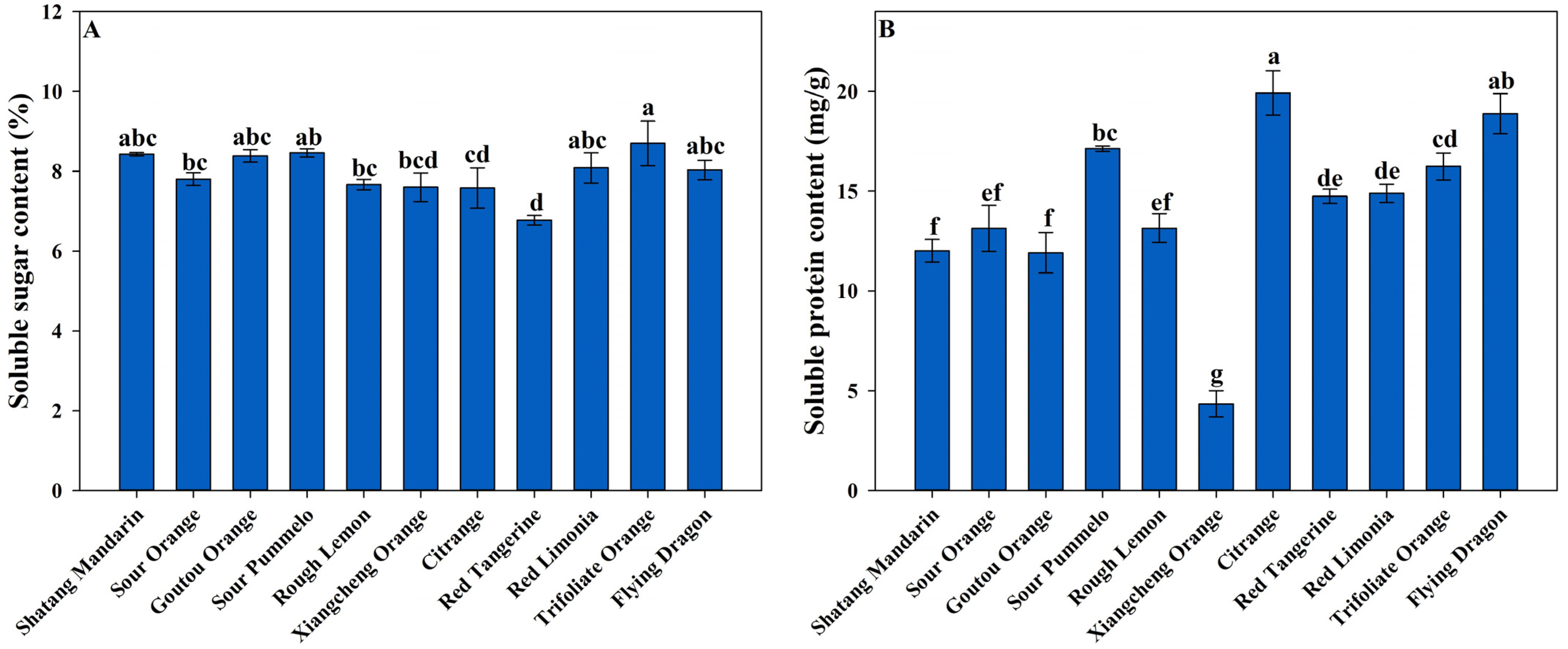
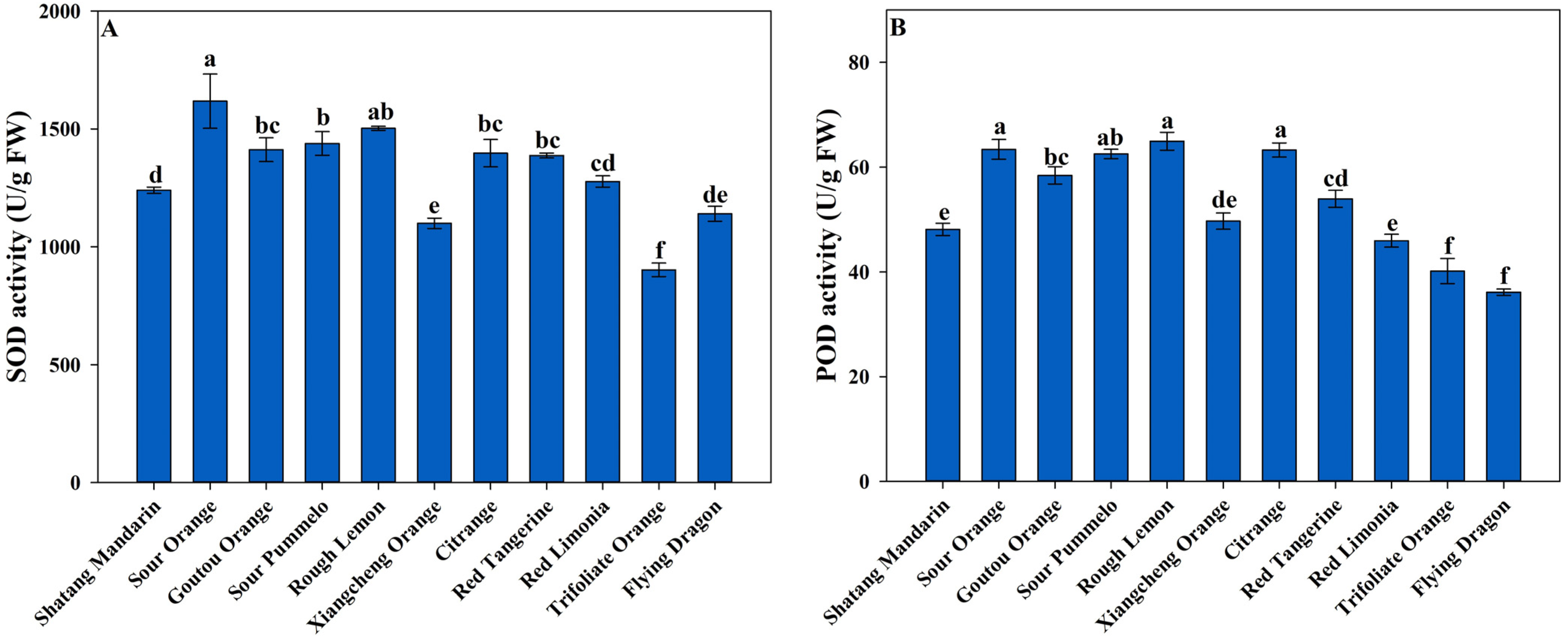

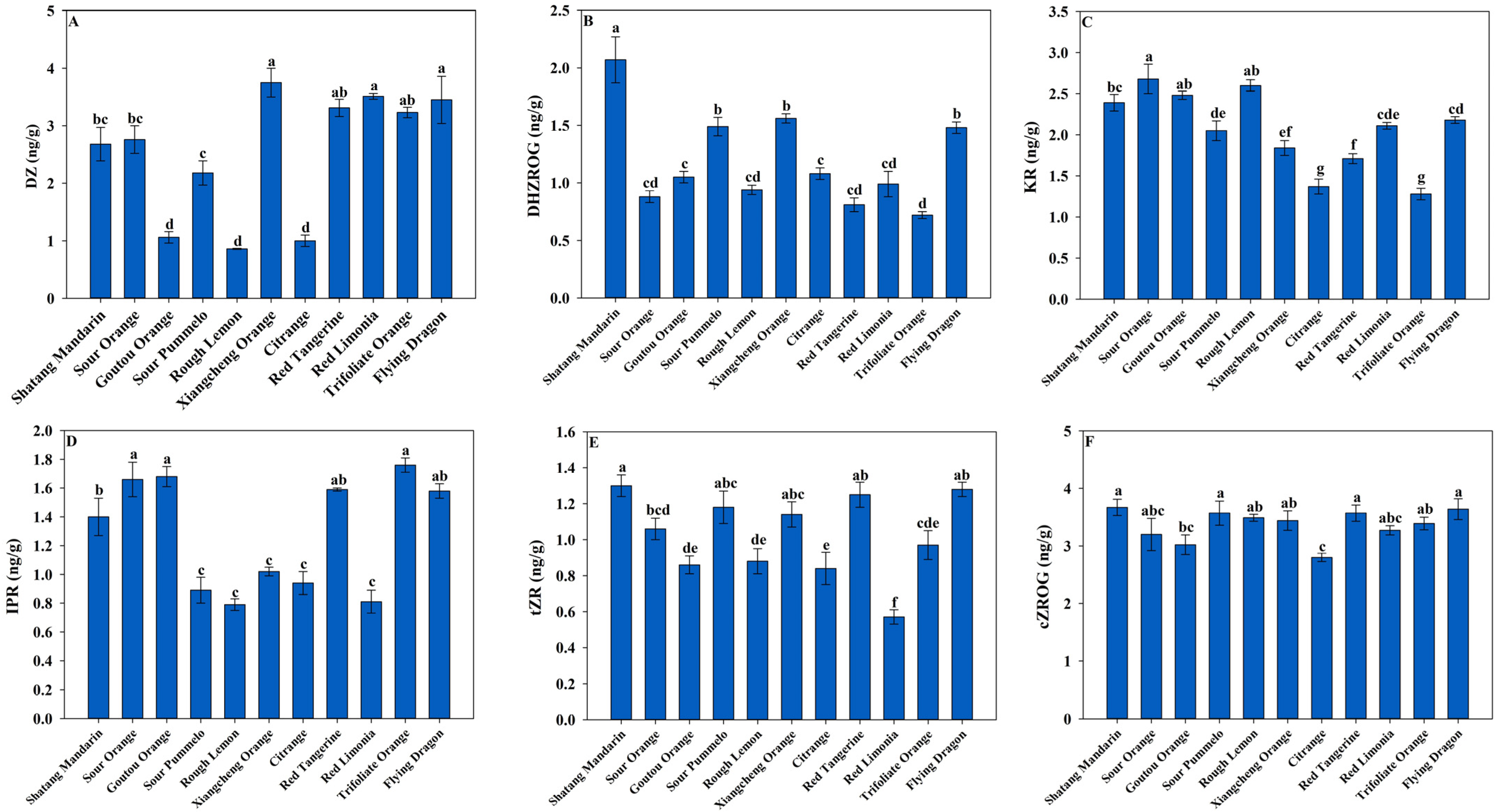


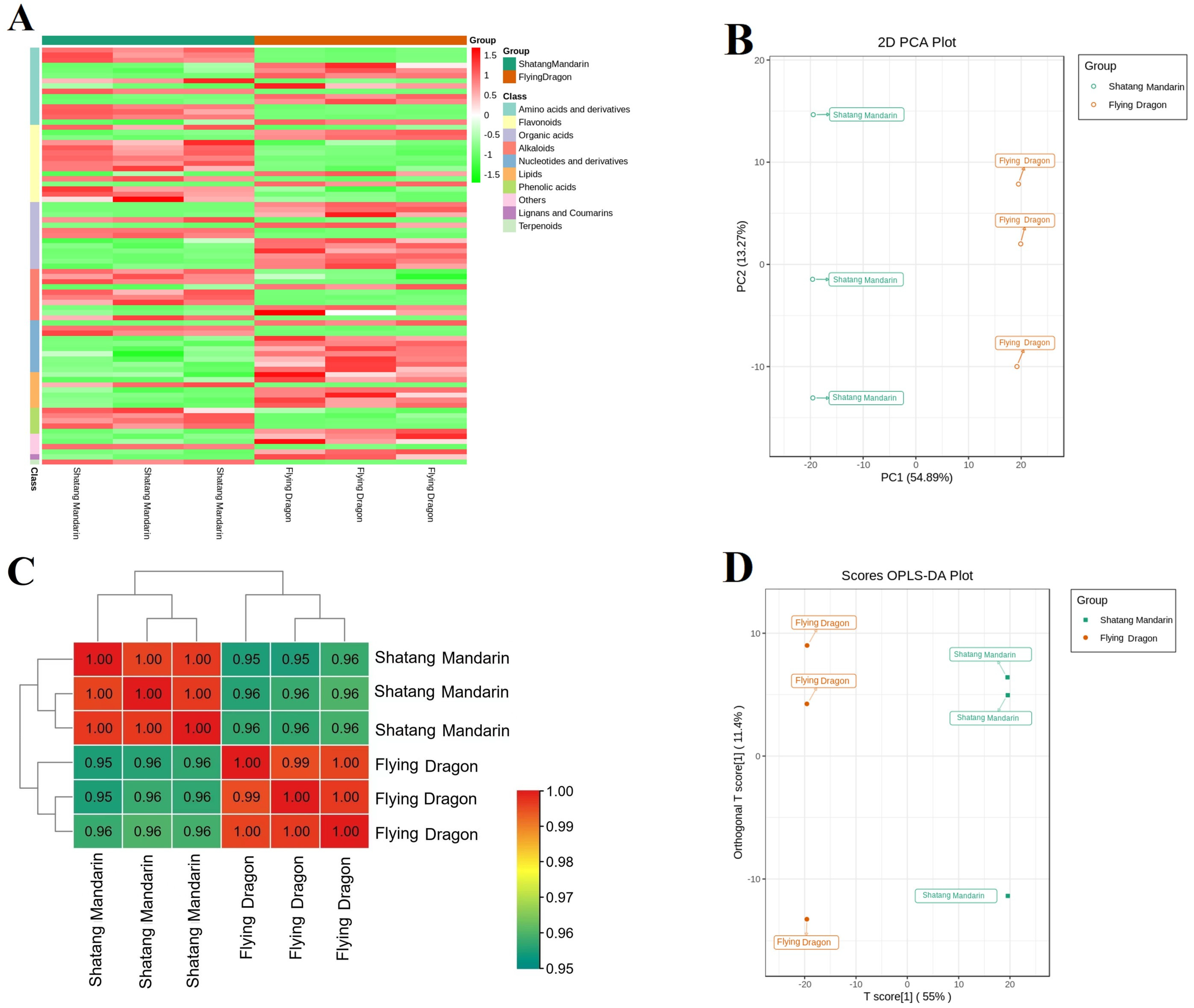
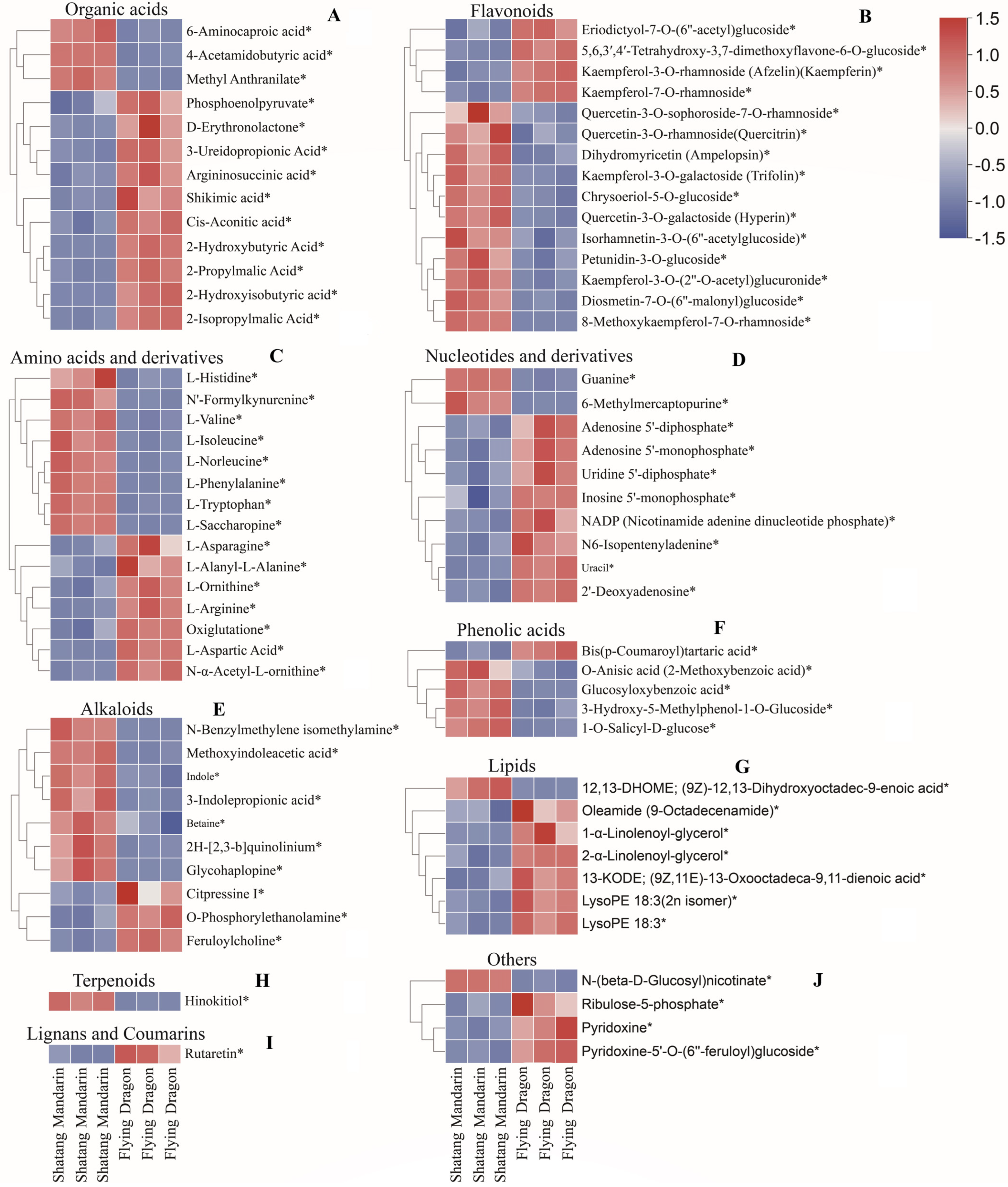
| Rootstock | Origin | Parentage | Characteristics |
|---|---|---|---|
| ‘Shatang Mandarin’ | China | Citrus reticulata Blanco cv. Shatangju | Vigorous |
| ‘Sour Orange’ | Asia | Citrus maxima | Vigorous |
| ‘Goutou Orange’ | China | Citrus aurantium L. | Vigorous |
| ‘Sour Pummelo’ | Southeast Asia | Citrus maxima | Semi-dwarf |
| ‘Rough Lemon’ | India | Citrus jambhiri Lush. | Semi-dwarf |
| ‘Xiangcheng Orange’ | China | Citrus junos Sieb | Semi-dwarf |
| ‘Citrange’ | USA | Citrus sinensis L. Osbeck × Poncirus trifoliata L. Raf. | Semi-dwarf |
| ‘Red Tangerine’ | Southeast Asia | Citrus reticulata Blanco | Semi-dwarf |
| ‘Red Limonia’ | India | Citrus limonia Osbeck | Dwarf |
| ‘Trifoliate Orange’ | China | Poncirus trifoliata L. | Dwarf |
| ‘Flying Dragon’ | Japan | Poncirus trifoliate Raf. var. monstrosa | Dwarf |
| Scion/Rootstock | Plant Height (cm) | Crown Width (cm) | Rootstock Diameter (mm) | Scion Diameter (mm) | Internodal Length (cm) | Number of Nodes | Number of Branches |
|---|---|---|---|---|---|---|---|
| ‘Shatang Mandarin’ | 181.8 a | 149 a | 26.5 a | 31.2 ab | 24.2 a | 6.80 bcd | 10.2 cd |
| ‘Sour Orange’ | 142.7 b | 93.7 c | 19.9 bc | 26.9 bc | 14.02 d | 7.80 abc | 11 bcd |
| ‘Goutou Orange’ | 133.3 bc | 113.5 b | 20.2 bc | 34.01 a | 18.3 bc | 6.60 cd | 9.40 de |
| ‘Sour Pummelo’ | 126.6 bcd | 92 cd | 21.9 b | 34.7 a | 9.63 e | 8.40 a | 13.8 a |
| ‘Rough Lemon’ | 122.8 bcde | 83.2 cde | 17.5 cd | 24.7 cd | 19.2 b | 6.80 bcd | 13.4 ab |
| ‘Xiangcheng Orange’ | 116.8 cde | 68.6 ef | 16.8 cd | 24.5 cd | 13.01 de | 8.20 ab | 14.4 a |
| ‘Citrange’ | 108.4 def | 79.2 cde | 17.7 bcd | 24.4 cd | 14.8 cd | 6.80 bcd | 12.2 abc |
| ‘Red Tangerine’ | 102.3 ef | 76.3 de | 16.0 cde | 23 cd | 13.2 de | 6.40 cd | 9.60 cde |
| ‘Red Limonia’ | 92.7 fg | 72.5 ef | 17.4 cd | 23.7 cd | 12.7 de | 6.60 cd | 10.6 cd |
| ‘Trifoliate Orange’ | 89.1 fg | 66.2 ef | 13.4 de | 25.5 cd | 12.8 de | 4.80 e | 7.40 ef |
| ‘Flying Dragon’ | 75.6 g | 56.8 f | 12.4 e | 20.1 d | 4.62 f | 5.80 de | 6.60 f |
Publisher’s Note: MDPI stays neutral with regard to jurisdictional claims in published maps and institutional affiliations. |
© 2022 by the authors. Licensee MDPI, Basel, Switzerland. This article is an open access article distributed under the terms and conditions of the Creative Commons Attribution (CC BY) license (https://creativecommons.org/licenses/by/4.0/).
Share and Cite
Hayat, F.; Li, J.; Liu, W.; Li, C.; Song, W.; Iqbal, S.; Khan, U.; Umer Javed, H.; Ahsan Altaf, M.; Tu, P.; et al. Influence of Citrus Rootstocks on Scion Growth, Hormone Levels, and Metabolites Profile of ‘Shatangju’ Mandarin (Citrus reticulata Blanco). Horticulturae 2022, 8, 608. https://doi.org/10.3390/horticulturae8070608
Hayat F, Li J, Liu W, Li C, Song W, Iqbal S, Khan U, Umer Javed H, Ahsan Altaf M, Tu P, et al. Influence of Citrus Rootstocks on Scion Growth, Hormone Levels, and Metabolites Profile of ‘Shatangju’ Mandarin (Citrus reticulata Blanco). Horticulturae. 2022; 8(7):608. https://doi.org/10.3390/horticulturae8070608
Chicago/Turabian StyleHayat, Faisal, Juan Li, Wen Liu, Caiqing Li, Wenpei Song, Shahid Iqbal, Ummara Khan, Hafiz Umer Javed, Muhammad Ahsan Altaf, Panfeng Tu, and et al. 2022. "Influence of Citrus Rootstocks on Scion Growth, Hormone Levels, and Metabolites Profile of ‘Shatangju’ Mandarin (Citrus reticulata Blanco)" Horticulturae 8, no. 7: 608. https://doi.org/10.3390/horticulturae8070608
APA StyleHayat, F., Li, J., Liu, W., Li, C., Song, W., Iqbal, S., Khan, U., Umer Javed, H., Ahsan Altaf, M., Tu, P., Chen, J., & Liu, J. (2022). Influence of Citrus Rootstocks on Scion Growth, Hormone Levels, and Metabolites Profile of ‘Shatangju’ Mandarin (Citrus reticulata Blanco). Horticulturae, 8(7), 608. https://doi.org/10.3390/horticulturae8070608








